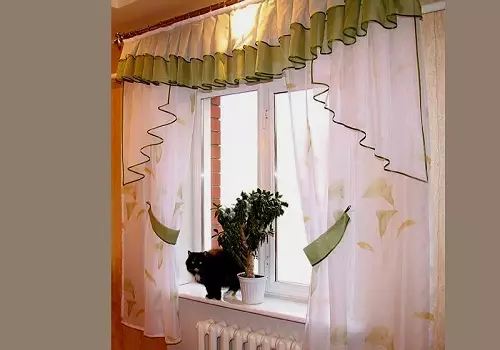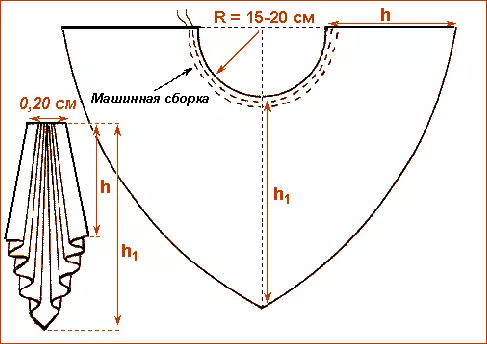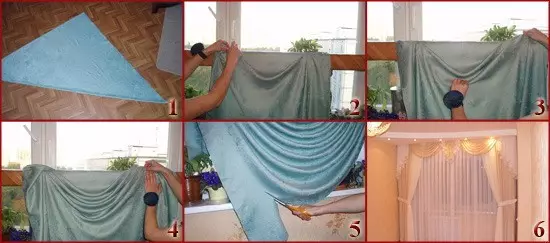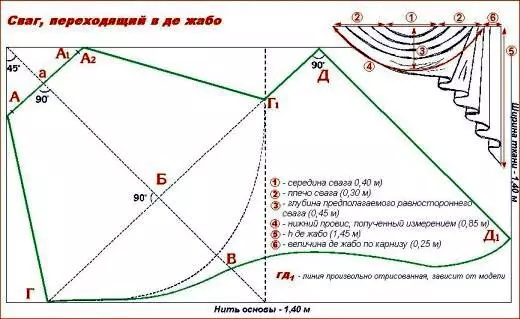Labreken is often used to decorate the window opening and the porter. This is a reception of decorating from the fabric, Lamberken framed the top of the curtains, hides the cornice. Drapery is attractive and stylish. To sew such a form with your own hands, you need to correctly perform the cutting lambrequin, which is not so difficult, as it usually seems at first glance. A simple example of Lamberken for the kitchen is shown in Fig. 1.

Figure 1. To create a lambrequin, a special drapeting fabric is best suited, which will be easy to form in soft attractive folds.
Types of folds for curtains
The lambrequin fold is the main part for which you need to pay attention. Depending on which folds will be used, the lambrene takes excellent form from each other.
Today, you can collect such options:

Figure 2. Cocill pattern.
- De Zabo is the side of the curtain, which has a spawned look, it goes only at one edge, all the folds are laid down for each other.
- Kokille is a complex element, usually dual, which provides symmetry and attractiveness to Lambreken. Often such forms are still called skirts (remind them in appearance). The example of Kokil can be viewed in Fig. 2.
- Curses or bells are a conical shape of drapery, which are gently falling around.
- The cake is a cloth that throws up a soft wave through the cornice or the mounting bar.
- The balloon is draping, which is only in a horizontal position.
Master class on sewing soft lambrequin
To sewing a soft lambrequin into a fold, you must first select the form. For example, for a high and narrow window, too short folds are absolutely not suitable, as they will only emphasize what you need to hide. For the classic interior, jabs or cascade are used, which advantageously emphasize all the details of the room. . To cut the lambrequin such a form and tailoring, it is necessary to prepare the following materials and tools:
Article on the topic: The plastic door does not close: what to do and how to adjust?

Figure 3. Step-by-step lambrequin cutting with mounting board.
- The fabric is best to take a special drapery, which will be easy to form in soft and attractive folds. The width of the tissue cut is 137 cm.
- Lining fabric width of 137 cm. Such a piece of fabric can be tested under the color of the main one, but it is best to use a contrast tint, which gives Lambonen special attractiveness.
- Natural flax ribbon with 2.5 cm wide.
- If necessary, you can use a special finishing tape.
- The mounting board, on which the folds will be formed during the sewing. The cutting lambrequin cannot be correctly made without such a board, as it helps to determine which amendments are needed, in which direction it is better to turn the folds, at what height to stack them. An example of using such a board is demonstrated in Fig.3.
- Thrust threads, conventional stapler for furniture upholstery, kraft paper, scissors and needles.
- Sewing machine.
Calculations and Pattern Building
Now it is necessary to determine the dimensions of the future lambrequin, for this it is necessary to obtain the following data:
- The width of the width is the size of the mounting board. It is equal to the width of the window opening, instead of the board often use a homemade design of 2 chairs and a conventional stick, shifted through the backs.
- The wague height is the depth of the fold, which is measured from the central part of the vertex to the lower point.
- The length of the lambrequin arc is the total length for the proviscial fold, which starts from the middle and goes through the bottom point until the next site.
- The length of the cascade is a vertical fold. The most optimal value is the ratio at which the length of the cascade is equal to the 3rd length of the wagon height.
- Width for the lambrequin cascade. This is 1/3 of the width of the Swag, to which the width of the mounting board is added.
How to cut out? To make label with folds, it is necessary to build a pattern (Fig. 4):
Article on the topic: how to make a screen for a bath

Figure 4. Pattern of lambrequin with folds.
- On a large sheet of paper, the vertical line is drawn, for which point A.
- A mark is set, where A-B is the height of the wague, multiplied by 2. Then 12.7 cm is added so that the height is 47.5 cm.
- The marked points A and B are connected by the line.
- Now it is noted ¼ from the width of the width. Next, it is noted ½ for the length of the arc.
After that, you can proceed to the pattern of the cascade for the future lambrene, the construction of folds. This is the most responsible stage, as the lambrene receives its form only after all the folds are collected and fixed. Without them, it will be just a piece of fabric that closes the cornice. If it is necessary to observe such a rule: for a longer middle part of the lambrequin, it is necessary to use a greater number of horizontal folds. This will allow the form of special elegance and decorativeness. Curtains will turn out more voluminous, allow you to highlight the necessary items of the whole structure.
To form a folding lambrequin, you need to use special tables that show the relationship between the number of folds, their depth, width, total. Correquency size and shape can be directly on the mounting board, for which it is intended.
Instructions for sewing
After the pattern is ready, it is necessary to cut the cloth, fold the 2 pieces of the face. On the 3rd sides, the billet is stitched. During the cutting, you must not forget that you need to leave the allowances for the seams. As a result, it should be possible:
- 1 Swag;
- 1 lining;
- 4 cascades.
The central part of the folds will be a drawing for the future lambrequin. When the fabric is selected with a pattern or beautiful embroidery, the print, it is necessary to ensure that there is a beautiful and symmetrical pattern during the formation of the fold. This is an important point that cannot be missed. If there is no confidence in your abilities, it is best to take a monophonic fabric.
Article on the topic: Canopy for mangala do it yourself
The sewing instruction itself is extremely simple:

Table volume table for lambrequin.
- It is necessary to get the top part of the Swag, after which it is to try the resulting seam, repeat it for lining fabric.
- All items are folded to each other by the front sides, paste together.
- If a decorative braid is applied, then it is necessary to set it between the main and lining tissue.
- During the attachment, 1 part should be left open so that you can turn the part to the front side.
- After turning the curtains, it takes off, you can proceed to the formation of folds.
- The mounting board turns into a cloth under the color of the lambrequin. Now you can proceed to the most important part - the formation of the appearance.
- The upper point is noted in such a way that the edge across the riding is about 2.5 cm. After that, the first fold is laid and fastened with a stapler.
- Similarly, it is necessary to strengthen all other folds, the edge of 5 cm should remain over the board, which will then be removed.
The last side ends are attached, if necessary, all excess fabrics are removed on the opposite direction of the mounting board so that neither them nor the most of the foundation can be seen.
It is recommended to use a beautiful braid on top of the top, which will completely hide all fasteners.
Lambreken is a beautiful and interesting design, fixed at the cornice level for the porter. This form makes it possible not only to hide the cornice, but also make up the windows of the window more attractive, remove some disadvantages of window openings, make the interior more finished and complete. With your own hands, tailoring is not so difficult, but there is a need to comply with many features, including formation of folds.
